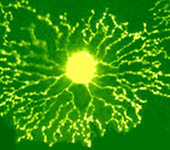Transcription Factors in Neurogenesis
 Neurogenesis requires careful coordination of cell division, necessary to generate a large tissue, with differentiation, which generates individual neurons and glia. The retina is the simplest and best-studied part of the CNS, and is thus an excellent model system to study factors that control division and differentiation. Neurogenesis requires careful coordination of cell division, necessary to generate a large tissue, with differentiation, which generates individual neurons and glia. The retina is the simplest and best-studied part of the CNS, and is thus an excellent model system to study factors that control division and differentiation.
Our work on Rb (see News.) has revealed the role of Rb in development of different retinal neurons and glia. We are also studying the role of the homeobox gene Chx10 in retinal development. Chx10 is essential for normal levels of proliferation in the early stages of retinal development and the differentiation of bipolar cells near the end of retinogenesis. We showed that Chx10 is a repressor. J Biol Chem. In press. This led us to hypothesize that Chx10 may promote the genesis of bipolar neurons by repressing genes required for the formation of other cell types that are produced at the same time. We are investigating this possibility now.
Defects in Chx10 cause the blinding disease microphthalmia (i.e. small eyes) in children. A close relative, Vsx1, is mutated in diseases that affect both the cornea and retina. We have characterized the functional effects of some of these mutations (Héon E, et al 2002) PDF (Dorval K, J Biol Chem. In press.)
|






